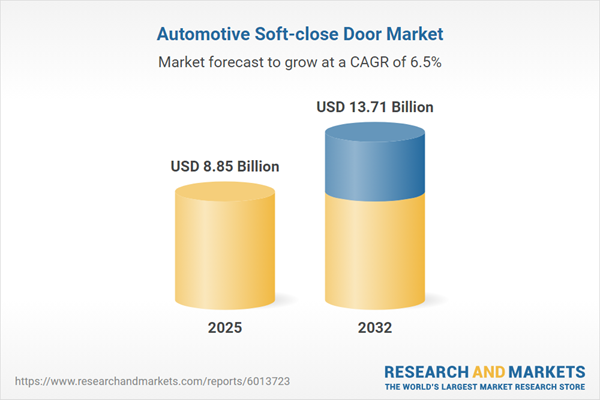Speak directly to the analyst to clarify any post sales queries you may have.
Senior automotive leaders recognize the growing importance of soft-close door systems as the market evolves. As innovation cycles accelerate and industry expectations rise, a strategic understanding of the automotive soft-close door market is vital for achieving product distinction, operational compliance, and a competitive edge.
Market Snapshot: Automotive Soft-Close Door Market Growth Trends
The automotive soft-close door market is experiencing steady advancement, with strong momentum driven by dedicated investments. This growth is evident across both luxury vehicles and an increasing number of mainstream models. A notable compound annual growth rate underlines strong market demand. Industry projections show OEMs and suppliers are prioritizing enhanced comfort, improved noise insulation, and advanced safety features. As regulatory standards become more demanding, manufacturers are moving towards these systems to achieve differentiation and consistently meet compliance expectations. The technology’s popularity extends across established automotive markets and emerging economies, demonstrating a clear consumer preference for vehicles equipped with modern door solutions and superior interior experiences.
Scope & Segmentation: In-Depth Market Analysis of the Automotive Soft-Close Door Market
This report provides actionable insights for senior automotive executives, focusing on key sectors and strategic opportunities as the market transitions toward advanced door systems. The research examines:
- Vehicle Types: Covers heavy commercial vehicles, buses, premium and standard passenger cars, light-duty vans, and pickups, with analysis of distinct integration trends that impact sector strategies.
- Actuation Types: Evaluates electric drive solutions, including DC brushless and switched reluctance motors, alongside hydraulic systems—single and dual cylinder—and pneumatic designs, detailing their fit for different vehicle architectures.
- Material Types: Highlights the use of aluminum die castings and extrusions, composites, high-performance plastics, and steel, analyzing their roles in supporting regulatory compliance and weight reduction targets.
- End-Use Applications: Addresses OEM installations for new models and aftermarket opportunities for retrofit solutions and fleet upgrades, with insight into the full product lifecycle value.
- Geographic Coverage: Assesses the Americas, Europe, Middle East and Africa, and Asia-Pacific, offering perspectives on technology adoption speed, local regulatory drivers, and strategy adaptation by region.
Key market participants—Magna International Inc., Faurecia S.E., Aisin Corporation, DENSO Corporation, Adient plc, Lear Corporation, Gentherm Incorporated, Valeo SE, Yanfeng Automotive Interiors, and Johnson Electric Holdings Limited—fuel industry growth by investing regionally and evolving their product portfolios.
Key Takeaways for Senior Decision-Makers
- Soft-close door integration is now a central differentiator among OEMs and suppliers, helping enhance vehicle comfort and distinct brand positioning.
- Technological advances in electric and hydraulic actuation improve system compatibility and deployment flexibility, creating adaptive approaches to vehicle lifecycle management.
- Adopting lightweight, advanced materials not only addresses sustainability objectives but also improves operational efficiency and compliance across platforms.
- Supplier and automaker collaboration is intensifying, strengthening regional manufacturing agility to address shifting market and regulatory demands.
- Configurable system architectures provide brands the adaptability required to meet evolving segment-specific consumer expectations and compliance requirements.
- The integration of digital diagnostic features enhances service offerings and opens growth avenues in both the commercial and private vehicle spaces.
Tariff Impact: Navigating Supply Chains and Cost Volatility
Recent U.S. tariff changes on electric motors and specialty polymers are influencing procurement practices throughout the automotive soft-close door market. Manufacturers are responding by diversifying supply chains, building stronger relationships with local suppliers, and increasing regional production. These shifts are particularly significant for the aftermarket, helping companies strengthen supply resilience against changing regulations and input cost volatility while maintaining consistent value and quality standards.
Methodology & Data Sources
Findings in this report are based on secondary research, executive interviews, and industry whitepaper analysis. Insights are reinforced through examination of supplier documents, patent reviews, and continuous monitoring of global regulatory changes, keeping conclusions actionable and relevant.
Why This Report Matters
- Enables manufacturers and suppliers to optimize product development and successfully navigate go-to-market strategies within the evolving automotive soft-close door sector.
- Supports senior leaders in proactively addressing regulatory changes and strengthening supply chains for sustainable growth.
- Illustrates the value of regional partnerships and customized approaches in supporting industry transformation and protecting long-term competitiveness.
Conclusion
With access to the latest market intelligence, senior automotive executives can refine strategies, respond to changing conditions, and sustain leadership as demand for advanced soft-close door solutions grows.
Additional Product Information:
- Purchase of this report includes 1 year online access with quarterly updates.
- This report can be updated on request. Please contact our Customer Experience team using the Ask a Question widget on our website.
Table of Contents
3. Executive Summary
4. Market Overview
7. Cumulative Impact of Artificial Intelligence 2025
Companies Mentioned
The companies profiled in this Automotive Soft-close Door market report include:- Magna International Inc.
- Faurecia S.E.
- Aisin Corporation
- DENSO Corporation
- Adient plc
- Lear Corporation
- Gentherm Incorporated
- Valeo SE
- Yanfeng Automotive Interiors Co., Ltd.
- Johnson Electric Holdings Limited
Table Information
| Report Attribute | Details |
|---|---|
| No. of Pages | 195 |
| Published | October 2025 |
| Forecast Period | 2025 - 2032 |
| Estimated Market Value ( USD | $ 8.85 Billion |
| Forecasted Market Value ( USD | $ 13.71 Billion |
| Compound Annual Growth Rate | 6.4% |
| Regions Covered | Global |
| No. of Companies Mentioned | 11 |









